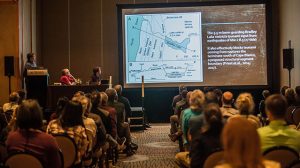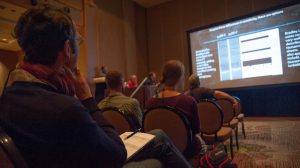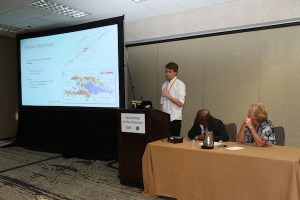Organizing a technical session might seem daunting, but there’s a lot that early-career scientists can gain from the experience. Here’s some advice on why – and how – you should consider organizing a session for SSA’s 2019 Annual Meeting.

Learn and network
The two main benefits of organizing a technical session are learning more about a topic that interests you and meeting other scientists.
Part of what makes SSA’s Annual Meetings a great learning opportunity is the way they’re created organically by members.
“Most annual meetings and conferences have pre-defined topics that you have to stick to,” says Southern California Earthquake Center’s Christine Goulet. “SSA’s meetings work really well because they let people tailor or design the sessions themselves.”
This active involvement by the community is reflected in the program, something that University of Colorado Boulder’s Peter Molnar sees as the primary reason early career scientists would want to organize a technical session.
“If you’re into a subject and you know there are people who have something to say that you can learn from, go do it” said Molnar.
Successful session conveners reach out broadly to let their colleagues know about the session and encourage participation.
For Michael Bostock, professor at the University of British Columbia and co-chair of the 2019 SSA Annual Meeting, this outreach “ensures that at least some of the cohort they are interested in interacting with are present at the meeting.”
His fellow co-chair, USGS’s Joan Gomberg, adds that “recruiting speakers is also a good way to meet new people” and “a good way to gain some visibility in the community.”
Choosing a topic
Elizabeth Vanacore, researcher at the University of Puerto Rico at Mayagüez and co-chair of last year’s meeting, suggests that “a good place to start is to think about what session you would like to see.”
Eric Calais of Ecole Normale Supérieure in France offers another useful starting point: “I would ask myself ‘what is the key question in my field that I can gather people around?’”
That question should be “something you and a community think is important” and “triggers interest because of its novelty.”
The session proposal
The next step is the proposal. Gomberg advises that “a good proposal should identify a topic of interest to a critical mass of people, contain a compelling description of why a session would be useful and what it will cover, and at least a few ideas for potential presenters.”
The description is “key to attracting other scientists to your session” according to Vanacore, who adds that it’s important to include “what types of abstracts you are looking for, and why the session is scientifically important or interesting.”
Getting speakers and conveners
For early-career scientists who may not have many contacts, reaching out to others – especially renowned scientists – may be intimidating. But it shouldn’t be.
“Early-career scientists should not be afraid to contact people they have not met,” says Gomberg, adding that conveners “need not be famous. Most important is their ability to speak clearly and keep speakers on schedule.”
The first step is to identify who you’d like to have speak at, or convene, your session. Looking to those you know – or you’ve at least met – is a good first step.
“Be brave,” says Vanacore. “At most meetings you meet and receive cards of other scientists who work within your specific area, so break out the rolodex and reach out.” She adds that “your mentors may have contacts you do not and may be able to help you with an introductory email or phone call.”
Bostock suggests another method is to “survey the recent literature to see who has been publishing in their target fields.”
 Promoting your session
Promoting your session
Once your session has been approved, it’s important to generate interest in it. “You can officially invite one or two speakers, then you target other relevant groups of people to publicize your session,” says Goulet, who advocates reaching out to institutions.
“Most research centers and groups have their own mailing lists – for example, if your session is on national seismic hazard maps, USGS has a mailing list for that. If it’s on seismology and wave propagation, you can contact SCEC. If you don’t know many people, that’s a good way to publicize your topic.”
Submit your proposal
SSA’s 2019 Annual Meeting takes place 23-26 April 2019 in Seattle, Washington. Technical session proposals can be submitted online from mid-August 2018 until 1 October 2018. For inspiration, take a look at technical sessions from last year’s Meeting.
